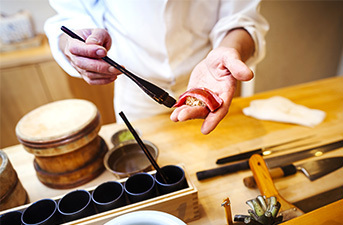Restaurants(3911)
Sushi Takahiro (Shinjuku)
Witness a prodigy at work. After just 13 years of training, Chef Ikuta Takahiro starts his own restaurant in Shinjuku, having joined the industry at just 18 years of age as an apprentice.
Hondori Sasa
This central Hiroshima restaurant prepares fresh Setouchi seafood and other local seasonal ingredients through a variety of ancient grilling methods that have been all but lost to time.
Sumiyaki Kaminari Shintenchi
This legendary Hiroshima yakitori restaurant uses a combination of “tohbi” distant-fire charcoal grilling to seal in the flavor, as well as a tashi-tsugi sauce that has been continuously added to for over 40 years of operation.
Kappo Sushi Hana Aza
Three of Fukuoka’s foremost experts in Japanese cuisine depart for an exciting new culinary adventure in the city’s Akasaka district. Novel kappo and sushi creations draw inspiration from cuisine both within and outside of Japan.
Sushi Kunimitsu
With a pedigree from some of the finest restaurants in Japan, America and Germany, Sushi Kunimitsu’s head chef enthralls guests with the combination of impeccable sushi and fluent English.
Ginza Yamashina
The head chef and manager at this Ginza yakiniku restaurant purchases an entire cow at a time, choosing each one for the perfect balance of fat and lean meat content — characterized by a deep red “azuki-iro” shade.
Steak ROKKAKUDO
Indulge in the finest teppanyaki at Steak ROKKAKUDO, a beloved institution since 1973 nestled at the foot of Mt. Utatsu in Kanazawa.
Tenjin Kurogeryu Yakiniku Mitsuboshi
The restaurant by Fukuoka’s riverside area calls itself a “meat expert,” combining the thrill of live yakiniku grilling with high-quality kuroge wagyu sourced from all over Kyushu Prefecture.
Mahoroba Irori Okinawa
In the seaside capital of Okinawa, the gentle glow of "irori" at Mahoroba Irori is a sight the coastal city hasn't seen in years. Here, Okinawa-grown meats are cooked over rustic sunken hearths powered by Tosa Binchotan charcoal.
TOHAKU CHAKAN
Within the Tokyo National Museum, this 270-year-old heritage building has been transformed into a creative fusion teahouse, where one of Tokyo’s most influential chefs proves that originality still has a place among traditionalists.
Shinjuku Gyoenmae Sushi Lab
Sushi Lab’s latest venue in Shinjuku taps into the unique Tsumoto technique, where the fish's blood is drained using water pressure, with an eager-to-experiment spirit and a focus on affordability.
Requinquer
At his Shirokanedai restaurant, Chef Souichi Furuya transforms ingredients that other chefs might typically overlook into haute French cuisine. Cuisine like galettes made from discarded vegetable parts have consistently earned him Michelin Stars.
Sushi Gion Matsudaya
Presenting Edo-style sushi, this restaurant is full of classic dishes combined with the chef’s very own intriguing ideas.
Nihonryori Takayama
At this traditional Japanese restaurant in Hiroshima, Chef Takayama pulls out all the stops to present an omakase course meal using local seafood, with the mission to “make people happy."
Sakabayashi
Kobe Shushinkan Brewery houses one of the city's most popular kaiseki restaurants, offering traditionally prepared course menus paired with some of the region's finest sake — especially the famed Fukuju — at an affordable price.
Hakata no Ouka
From the first mouthwatering sizzle of steak hitting the teppanyaki grill, to the final tender bite, expect the highest quality experience at this specialty Kobe beef restaurant in Fukuoka.
Kawabun
The oldest restaurant in Nagoya, a meal at Kawabun is a cultural experience in its own right. Enjoy fine traditional dining in the surroundings of a ryōtei which has entertained the Nagoya elite for over 400 years.
Nishinakasu Yakiniku Kiraku
Set in the riverside district of Nishinakasu, this yakiniku restaurant makes its way from Roppongi to Fukuoka, offering the same top-notch wagyu beef and luxurious atmosphere as the original Tokyo outlet.
Edomae-Charcoal-Grill Kemuri Kagurazaka
Located in the former geisha district of Kagurazaka, Kemuri preserves a different element of Japanese history and culture: irori-yaki (cooking over a sunken hearth). Come taste each ingredient, carefully grilled to bring out its purest flavors.
Sushi Yon
Boasting the "best private room in Minato Ward," this sushi restaurant has witnessed countless life-changing moments in a space as stunning as the sushi it serves.
Kiraku (Kagurazaka)
Welcome to Kiraku, a historical dining spot along the stone-paved streets of Kagurazaka. Here, you can experience “Tsumoto-style” aged sushi, where fresh fish is skillfully prepared using the renowned Tsumoto method to enhance its delicate flavors.
Unagi Kappo Ooedo
Unagi Kappo Oedo repeatedly immerses whole pieces of eel within jars of their secret sauce, letting its flavor suffuse the meat entirely. It is then paired with sticky Yumegokochi rice for maximum texture.
Ganko Kyoto Station
Transport yourself into the past at this Kyoto Station fixture, which has an eye-catching facade straight out of the Edo period. Popular with commuters looking for a quick bite, it’s also known to be excellent for sukiyaki or kaiseki courses.
Ganko Kameoka Rakurakusou
Indulge in a succulent sukiyaki or kaiseki course meal beneath the rafters of one of Japan’s Tangible Cultural Properties.
Tempura Ginza Onodera Namikidori
This Ginza tempura restaurant’s counter-only seating allows guests to observe masters at work.
Courage
Don’t let the psychedelic exterior of this Azabu-Juban establishment fool you: Courage’s strength is unpretentious, back-to-basics French cuisine at its finest, with an emphasis on sustainable ingredients.
USHIHACHI Akihabara
Visitors to Akihabara may spend most of their budget on computer parts or anime merchandise—but the high “cospa” of this yakiniku specialist means that they’ll still be able to afford a high-quality wagyu beef dinner at the end of the day.
CRAFEAT
Conceptualized by a team led by a 10th-generation Wajima-nuri lacquerware artisan, CRAFEAT highlights the beauty of Ishikawa Prefecture’s seafood and produce by serving up impeccable kaiseki-style courses on breathtaking traditional tableware.
